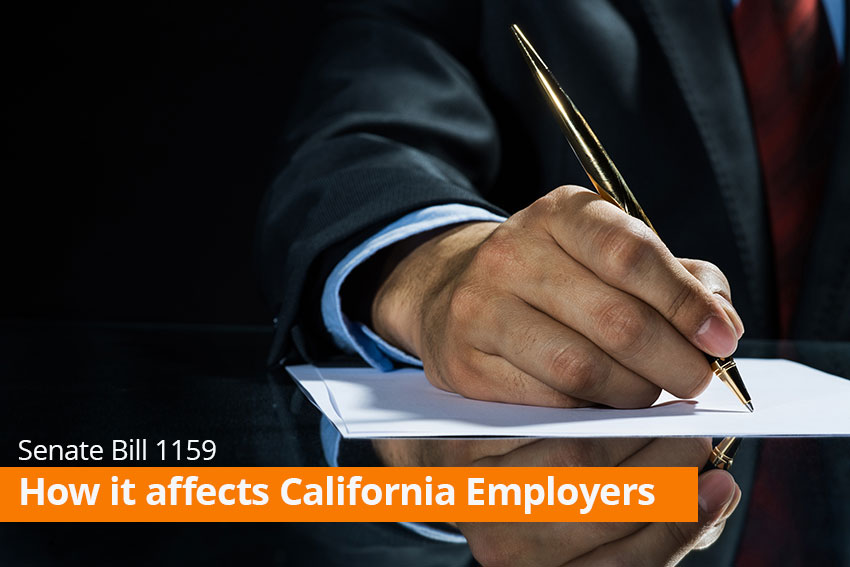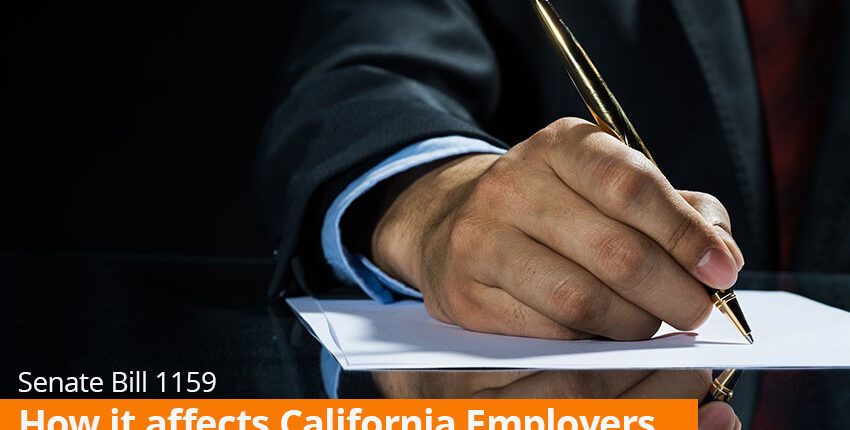
Senate Bill 1159 – How it affects California Employers
What is Senate Bill 1159?
Governor Newsom signed Senate Bill 1159 (“SB 1159”) on September 17, 2020. It created new laws that affect California employers with employees who test positive for COVID-19. One of these, Labor Code Section 3212.88, applies to California employers who have five (5) or more employees. It established that if a COVID-19 outbreak occurs at a place of employment, it may be assumed that employees who test positive for COVID-19 contracted it at work.
What does this mean?
- This law creates new reporting obligations for employers. In the first part of this article, we’ll discuss those new reporting obligations and how employers can meet them.
- SB 1159 also creates new presumptions of workers’ compensation compensability to workers. In the second part of this article, we’ll examine what those new presumptions are, and what an employer can do to reduce the risk of Covid exposure to its employees and protect itself in the process.
It should be noted that this is a complex law with onerous reporting obligations for California employers. Workers Comp insurers are uniquely positioned to be able to assist employers in complying with this new law, however each insurer is approaching this situation differently. The key to complying with this law is to look to your own workers comp carrier’s indicated response pathway and follow their specific direction closely.
New Reporting Obligations for Employers
What are the new reporting obligations for employers under SB 1159?
- Employers must report to their Workers Compensation claims administrator via email or fax when they are aware that an employee tested positive for COVID-19, regardless of whether the employee is making a claim under Workers Comp, and regardless of whether the infection is believed to be work-related.
- Positive test results must be by a Polymerase Chain Reaction (PCR) test or other viral testing approved by the Federal Drug Administration (FDA).
- Positive antibody tests should not be reported.
- The employer may not provide identifying information about the employee unless that employee asserts the infection is work-related.
When should I report this data?
- If you have five (5) or more total employees, fax or email your Workers Comp insurer:
- Within three (3) business days of knowledge (or when it should reasonably have been known) that there was a positive test on or after September 17, 2020.
- If you know of positive test results that occurred between July 6, 2020, and prior to September 17, 2020, you must report each positive test occurrence by October 29, 2020.
- If you have less than five (5) total employees, you are not required to report any additional data outside the claim reporting process.
What type of COVID-19 test do I need to report?
- Report positive COVID-19 results taken from a PCR test (or other viral testing approved by the FDA).
- Do not report positive antibody tests.
Each insurer will have its own reporting pathway for its policy holders. It is important that you carefully follow communication from your own insurer on how to work with their specific reporting arrangements. For specific questions, you are likely to get the most current response from your insurer’s current claims-reporting hotline.
New Presumptions of Workers’ Compensation Compensability
SB 1159 has two sections that apply new presumptions of workers’ compensation compensability to workers.
First, Section 3 of the new law applies a disputable presumption of workplace compensability until January 1, 2023, for anyone infected with COVID-19 who works as a firefighter, peace officer, or in a broadly defined set of health care professions. To qualify for the presumption, workers must receive a positive “PCR” test (not an antibody test) for COVID-19 within 14 days of working at a place of employment on or after July 6, 2020, and within 14 days of their termination from employment; and if a “health care professional,” the worker must provide direct patient care.
- Although the presumption is disputable, Section 3 contains no explanation as to what types of facts or evidence is needed to successfully dispute the presumption. Further complicating this is that the law requires the claims administrator to determine compensability within 30 days (compared to the normal 90 days). All usual workers’ compensation benefits are due, except that paid sick leave benefits created specifically in response to COVID-19 (e.g., through the CARES Act or certain state laws) must be exhausted before temporary disability is paid, and the state waives any right to collect death benefits for workers who die without dependents.
Section 4 of the new law applies to every other business in California that has five or more employees. Statutory duration, benefits owed, testing, and the disputable nature of the presumption are the same as Section 3, but there are key differences as follows:
- The presumption arises only if there is an “outbreak,” which is defined as four or more positive tests in a “specific place of employment” where the employer has 100 or fewer employees. If the employer has over 100 employees, an “outbreak” is 4% of the highest number of employees who reported to the same “specific place of employment” within 14 days of a positive test. The “highest number” is the greatest number of employees working at that specific place of employment in the preceding 45-day period.
- “Specific place of employment” is defined to encourage separation of work units by building, facility, agricultural field, etc. This helps employers who diligently and consistently divide work crews as the “outbreak” presumption will not carry across carefully divided work units.
- Note: This is an important section for employers’ attention, as careful, consistent practices can control virus spread, as well as application of the outbreak presumption. Accordingly, we have seen insurers recommend the following:
- Employers proactively limit employees’ movement within the place of employment, including access to shared areas like restrooms and break/lunch rooms.
- Employers should also limit any intermingling of employees in different work locations.
- Employers should communicate these limitations to employees, have them acknowledge the communication in writing, and take appropriate disciplinary action if these rules are violated.
Evidence to rebut the presumption of compensability can include showing: (i) there were “measures in place to reduce potential transmission”; and (ii) the employee had “non- occupational risks” of infection.
Note: This section encourages safety at work and knowledge of employee activities outside work. While safety measures are generally not relevant in workers’ compensation claims to reduce or dispute exposure, the unique challenges created by COVID-19 have led to new approaches. It is critical that you implement appropriate safety measures and document those efforts.
Consequently, insurers have recommended the following:
- Conduct a thorough hazard assessment and implement site-specific infection control strategies that include use of appropriate engineering and administrative controls, safe work practices, and personal protective equipment (PPE) to prevent employee infection.
- All employees should be trained on applicable COVID-19 infection prevention safety measures, including limiting movement to appropriate work locations, as well as all other essential program elements. Further, all employee training should be effectively documented. At a minimum, employers should use a combination of written documents, photographs, and video to help verify its efforts.
As explained above, the recent changes in the law create an unprecedented opportunity for employers to keep their employees healthy and safe while minimizing or eliminating exposure to COVID-19 claims.
The insurance industry is uniquely positioned with the resources and experts available to help you effectively manage through these changes. It is critical that you work with your workers comp provider to manage this risk and address reporting obligations, as each carrier will have its own pathway, especially during the early stages of implementing response protocols to address this new law.
If you have any questions, we can help. We welcome the opportunity to assist in these unique and challenging times.

About the Author
Larry St. John is a 20+ year veteran of insurance and risk management for the construction and electronic security industries.
He can be reached at LStJohn@eclipseinsurance.com




